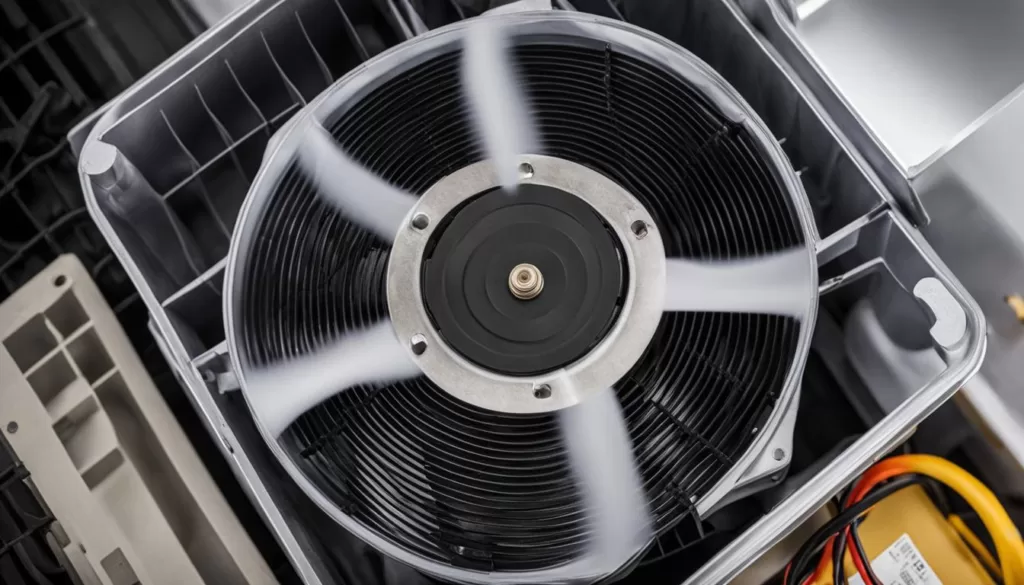If your refrigerator is not as cold as it used to be, it can be frustrating and may compromise the freshness of your food. However, there are several simple steps you can take to troubleshoot and optimize its cooling performance.
First, start by checking the temperature setting of your refrigerator. Ensuring that it is set to the appropriate level can make a significant difference in its cooling efficiency. Additionally, you’ll want to promote proper airflow within your fridge to maintain optimal cooling. Blockages in the circulation vents can hinder the cooling process.
Maintaining clean condenser coils is another important step. Over time, dust and dirt can accumulate on the coils, reducing their effectiveness. Regularly cleaning them will maximize the cooling efficiency of your refrigerator.
Inspecting the gasket seal and the fan motors of your refrigerator can also help identify any issues that may be affecting its cooling performance. A damaged gasket seal or malfunctioning fan motor can compromise cooling efficiency.
By following these easy steps, you can bring back optimal cooling to your fridge and ensure that your food stays fresh for longer.
Key Takeaways
- Check and adjust the temperature setting of your refrigerator for optimal cooling performance.
- Promote proper airflow within your fridge by keeping the circulation vents unobstructed.
- Regularly clean the condenser coils to maximize cooling efficiency.
- Inspect the gasket seal for any damage and replace if necessary to prevent air leakage.
- Regularly inspect and maintain the evaporator and condenser fan motors to enhance cooling performance.
Check the Temperature Setting
Start troubleshooting by checking the temperature setting of your refrigerator. If the temperature is set too high, gradually adjust it to a cooler temperature until your fridge reaches the appropriate level. It is recommended to keep the temperature between 33ºF to 40ºF for optimal cooling performance. This simple adjustment can significantly enhance the cooling efficiency of your refrigerator.
Proper temperature settings play a vital role in optimizing the cooling performance of your refrigerator. When the temperature is too warm, your food may spoil quickly, while a temperature that is too low can result in frozen items. Finding the right balance is crucial to ensure your groceries stay fresh and your energy consumption remains efficient.
“Setting the temperature within the recommended range of 33ºF to 40ºF creates an ideal environment for food preservation while preventing excessive energy usage.”
By setting the temperature within the appropriate range, you can maximize the cooling efficacy of your fridge while minimizing the risk of premature spoilage. It is important to note that different compartments within your refrigerator may have separate temperature controls. Refer to your appliance’s manual for guidance on how to adjust the temperature settings accurately.
Next, let’s explore how ensuring proper airflow within your refrigerator can further optimize its cooling performance.
Ensure Proper Airflow
Proper airflow is crucial for maintaining optimal cooling in your refrigerator. When the airflow is obstructed, it can lead to uneven cooling and temperature fluctuations, affecting the freshness of your food. To optimize refrigerator airflow, follow these simple steps:
1. Clear Circulation Vents
Check and ensure that nothing is blocking the circulation vents in your refrigerator. These vents are responsible for distributing cool air throughout the fridge. Remove any food items, containers, or debris that may be obstructing the vents. Keeping them clear allows for uninterrupted airflow and efficient cooling.
2. Fill Up Empty Spaces
An empty refrigerator can disrupt airflow and cause temperature imbalances. To mitigate this, fill up some space by placing jugs of water or other items in the empty areas. This helps maintain a steady temperature by minimizing the empty spaces that can hinder proper airflow.
3. Arrange Items Strategically
When organizing your fridge, consider the placement of items to optimize airflow. Place taller items towards the back of the shelves and shorter items towards the front. This arrangement ensures that air can circulate freely, preventing pockets of warm air from forming and maximizing cooling efficiency.
4. Clean the Air Ventilation System
Regularly clean the air ventilation system of your refrigerator to remove any dust or debris that may accumulate over time. Use a soft brush or vacuum cleaner to gently remove the buildup from the vents and fan. This maintenance step promotes proper airflow and helps the refrigerator operate at its full cooling potential.
By following these simple tips, you can optimize refrigerator airflow and ensure that your fridge maintains consistent and efficient cooling. When the airflow is unrestricted, your refrigerator will perform at its best, keeping your food fresh and extending its shelf life.
Clean the Condenser Coils
One of the key steps to maximize refrigerator cooling efficiency and optimize the performance of the compressor is to clean the condenser coils. Over time, these coils can accumulate dust and dirt, which can hinder the cooling efficiency of your refrigerator.
To clean the condenser coils, start by removing the underplate or back plate from your fridge. This will give you access to the coils. Once exposed, use a vacuum with a brush attachment to gently remove the dust and dirt from the coils. Take care not to bend or damage the delicate fins of the coils.
Tip: Cleaning the condenser coils should be done at least twice a year, or more frequently if you have pets. This regular maintenance will help maximize the cooling efficiency of your refrigerator and prevent any potential issues with the compressor.
Cleaning the condenser coils not only improves cooling performance but also ensures the compressor can operate optimally. When the coils are clean, heat can dissipate more effectively, allowing the compressor to maintain the desired temperature inside the fridge.
By incorporating regular condenser coil cleaning into your refrigerator maintenance routine, you can prolong the lifespan of your appliance and enjoy consistent, efficient cooling for years to come.

Inspect the Gasket Seal
The gasket seal is a crucial component that ensures proper cooling in your refrigerator. Conducting regular inspections of the gasket seal is essential to troubleshoot any cooling problems. Pay attention to the condition of the gasket seal and check for any signs of damage or wear.
If you notice that the gasket seal seems dry, it is recommended to apply a thin layer of petroleum jelly to keep it moist. This simple step can help maintain the flexibility and effectiveness of the gasket seal.
In cases where the gasket seal is damaged, it is important to replace it promptly. A damaged gasket seal may lead to air leakage, which compromises the cooling efficiency of the refrigerator. By inspecting and maintaining the gasket seal, you can eliminate potential cooling issues and ensure optimal performance of your refrigerator.

Check the Evaporator Fan Motor
The evaporator fan motor is a critical component that circulates air within both the freezer and refrigerator compartments, ensuring proper cooling performance. By observing and maintaining the evaporator fan motor, you can maximize refrigerator cooling efficiency and enhance its overall performance.
To begin, unplug your refrigerator and locate the evaporator fan, which is typically positioned behind the freezer wall. Remove the fan cover and carefully inspect it for any debris or ice clogs that may impede the fan’s rotation. Additionally, check the fan blades for signs of damage or looseness that could affect its effectiveness. Spin the fan manually to ensure smooth and efficient motor function, as any issues can impact the airflow and cooling within your refrigerator.
Regularly checking and maintaining the evaporator fan motor can substantially optimize the cooling performance of your refrigerator, leading to improved freshness and reduced energy consumption.

Common Issues and Solutions for the Evaporator Fan Motor
| Issue | Solution |
|---|---|
| Debris or ice clogs obstructing the fan | Gently remove debris or defrost the ice clogs to restore proper airflow. |
| Blades damaged or loose | Repair or replace the fan blades to ensure optimal function. |
| Motor not spinning smoothly | Lubricate or replace the motor for efficient rotation. |
Inspect the Condenser Fan Motor
One of the crucial components responsible for optimizing the cooling performance of your refrigerator is the condenser fan motor. As the refrigerant flows through the condenser coils, the condenser fan motor works to cool it down. By inspecting and maintaining this motor, you can enhance the refrigerator’s cooling efficiency and optimize its performance.
To begin, locate the condenser fan motor, which is typically situated at the bottom back of the fridge. You can access it by removing the back panel. Once you have gained access, carefully check for any obstructions that may be blocking the fan blades. Clear away any debris or buildup that you find.
After removing any obstructions, inspect the fan for wear and tear. Look for signs of physical damage, such as cracked or bent blades. A damaged fan can impact its ability to cool the refrigerant effectively. If you notice any issues, consider replacing the condenser fan motor to ensure optimal cooling performance.
Additionally, ensure that the fan can move freely by gently spinning it. If you encounter resistance or stiffness, it may indicate supply problems or mechanical issues with the motor. In such cases, it is advisable to seek professional assistance or consult the refrigerator’s manufacturer for further guidance.
By regularly inspecting and maintaining the condenser fan motor, you can optimize the performance of your refrigerator’s compressor and enhance its overall cooling efficiency and performance.
Benefits of Inspecting the Condenser Fan Motor:
- Enhanced cooling efficiency
- Optimized compressor performance
- Improved temperature regulation
- Maximized energy efficiency
Condenser Fan Motor Inspection Checklist
| Inspection Steps | Actions |
|---|---|
| Locate condenser fan motor | Remove access panel to access the fan motor located at the bottom back of the fridge |
| Check for obstructions | Remove any debris or buildup that may be blocking the fan blades |
| Inspect fan for wear and tear | Look for signs of physical damage, such as cracked or bent blades |
| Ensure free movement | Spin the fan to ensure it moves freely without resistance |
| Consider replacement | If there are physical issues or supply problems, consider replacing the condenser fan motor |
Inspect the Electronic Control Board
The electronic control board acts as the brain behind your refrigerator’s operation, playing a vital role in its cooling performance. It is important to periodically inspect the control board for any signs of damage that may be affecting its functionality. Look for burnt connections or any visible wear and tear.
If you notice any damage to the electronic control board, it is recommended to consult your refrigerator’s manual or the manufacturer’s website for instructions on how to replace the board. Alternatively, you can schedule an appointment with a professional refrigerator repair technician who can address any electronic control issues effectively.
By ensuring the proper functioning of the electronic control board, you can troubleshoot and optimize the cooling performance of your refrigerator, allowing it to maintain the ideal temperature for keeping your food fresh.
| Signs of a Damaged Electronic Control Board | Potential Solutions |
|---|---|
| The display panel is not working or displays error codes. | Consult your refrigerator’s manual or manufacturer’s website for troubleshooting steps. If the issue persists, consider replacing the electronic control board. |
| The refrigerator fails to cool or maintains inconsistent temperatures. | Check for any visible signs of damage on the control board. If damage is detected, replace the board according to the manufacturer’s instructions. |
| The refrigerator constantly runs or cycles on and off frequently. | Inspect the electronic control board for burnt connections or loose components. Replace the board if necessary. |
Conclusion
Optimizing the cooling performance of your refrigerator is essential for preserving the freshness of your food and maximizing energy efficiency. By following the steps outlined in this guide, you can troubleshoot and enhance the cooling efficiency of your fridge. From checking the temperature setting to inspecting key components like the evaporator and condenser fan motors, each step contributes to optimizing the cooling performance of your refrigerator.
Ensuring that your refrigerator is set to the appropriate temperature and has proper airflow can significantly improve its cooling capabilities. Regularly cleaning the condenser coils and inspecting the gasket seal are also important maintenance tasks that enhance refrigerator cooling performance. Additionally, checking and maintaining the evaporator and condenser fan motors, as well as the electronic control board, can contribute to optimal cooling efficiency.
If you have followed all the troubleshooting steps and your refrigerator still fails to cool properly, it is recommended to seek the assistance of a professional refrigerator repair technician. They have the expertise to diagnose and resolve complex issues that may be affecting the cooling performance of your fridge.
FAQ
How can I optimize the cooling performance of my refrigerator?
To optimize the cooling performance of your refrigerator, you can follow these steps:
What should I check first if my refrigerator is not cooling properly?
Start by checking the temperature setting of your refrigerator. Make sure it is set to a cooler temperature within the recommended range of 33ºF to 40ºF.
How important is proper airflow for refrigerator cooling?
Proper airflow is crucial for maintaining optimal cooling in your refrigerator. Ensure that nothing is blocking the circulation vents and consider filling up empty space with jugs of water to assist with maintaining the temperature.
Why should I clean the condenser coils of my refrigerator?
Over time, condenser coils can accumulate dust and dirt, hindering the cooling efficiency of your refrigerator. Regularly cleaning the condenser coils can maximize cooling efficiency and optimize the performance of the compressor.
How can I troubleshoot cooling issues by inspecting the gasket seal?
Inspect the gasket seal of your refrigerator to ensure it is not damaged or dry. Apply a layer of petroleum jelly if necessary. A damaged gasket seal should be replaced to prevent air leakage that can compromise cooling efficiency.
What role does the evaporator fan motor play in refrigerator cooling?
The evaporator fan motor circulates air within the freezer and refrigerator compartments. Inspecting and maintaining the evaporator fan motor can enhance the cooling performance of your refrigerator.
How does the condenser fan motor affect refrigerator cooling?
The condenser fan motor cools the refrigerant as it flows through the condenser coils. Inspecting and maintaining the condenser fan motor can optimize the cooling performance of your refrigerator.
Why is it important to inspect the electronic control board?
The electronic control board is responsible for the operation of your refrigerator. Inspecting for damage and ensuring proper functioning can troubleshoot and optimize the cooling performance of your refrigerator.
What should I do if my refrigerator still fails to cool properly after troubleshooting?
If all troubleshooting steps have been exhausted and your refrigerator still fails to cool properly, it is recommended to seek the assistance of a professional refrigerator repair technician.